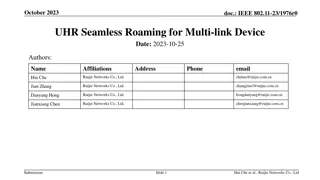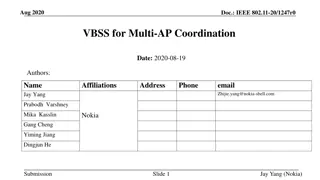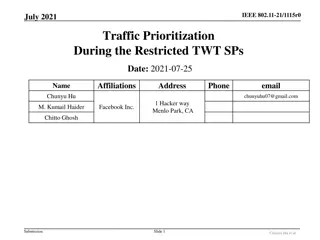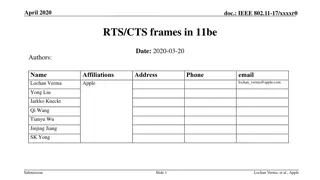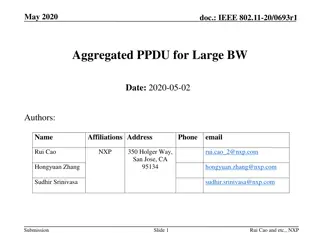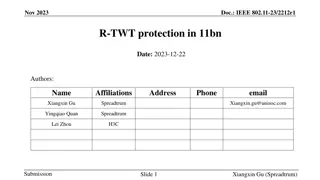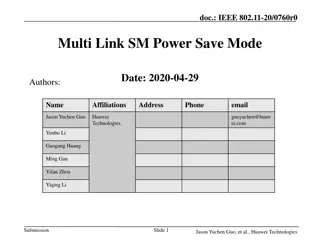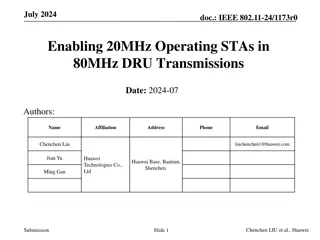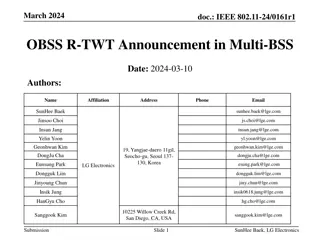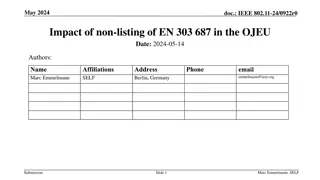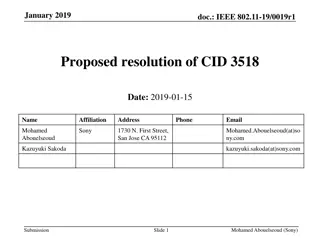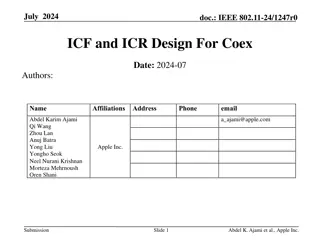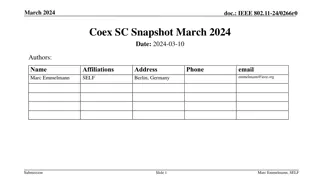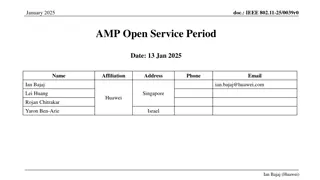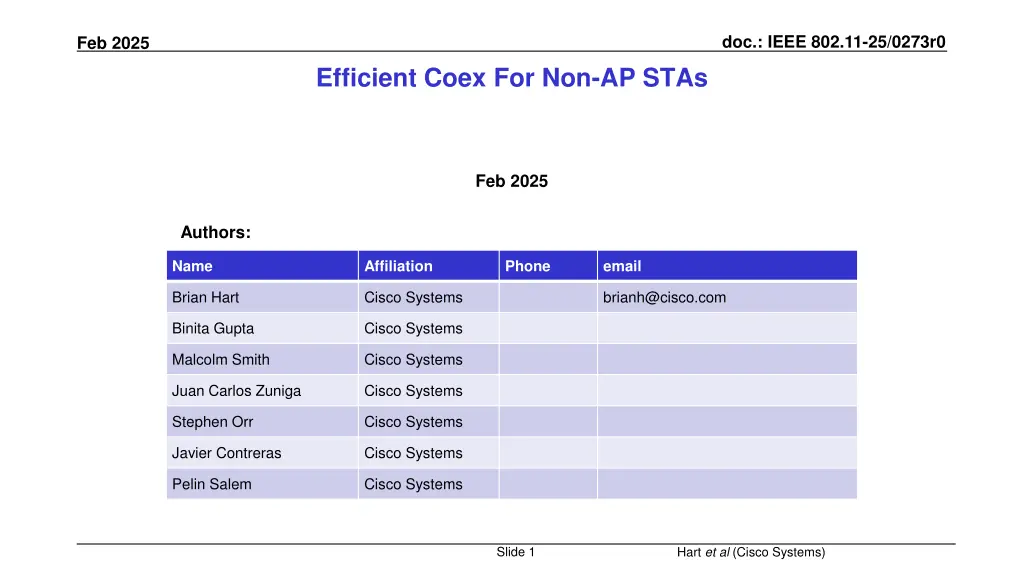
Efficient Coexistence for Non-AP STAs in IEEE 802.11-25/0273r0 Feb. 2025
Enhance efficiency in coexistence for non-AP STAs with the IEEE 802.11-25/0273r0 standard. Explore mechanisms such as PUO and DUO, addressing periodic and dynamic unavailability, with a focus on reducing overheads. Consider solutions like conditional support for DUO based on PUO support and enabling APs to send unsolicited PUO messages. Optimize channel utilization and improve system performance in wireless communication scenarios.
Download Presentation

Please find below an Image/Link to download the presentation.
The content on the website is provided AS IS for your information and personal use only. It may not be sold, licensed, or shared on other websites without obtaining consent from the author. If you encounter any issues during the download, it is possible that the publisher has removed the file from their server.
You are allowed to download the files provided on this website for personal or commercial use, subject to the condition that they are used lawfully. All files are the property of their respective owners.
The content on the website is provided AS IS for your information and personal use only. It may not be sold, licensed, or shared on other websites without obtaining consent from the author.
E N D
Presentation Transcript
doc.: IEEE 802.11-25/0273r0 Feb 2025 Efficient Coex For Non-AP STAs Feb 2025 Authors: Name Affiliation Phone email Brian Hart Cisco Systems brianh@cisco.com Binita Gupta Cisco Systems Malcolm Smith Cisco Systems Juan Carlos Zuniga Cisco Systems Stephen Orr Cisco Systems Javier Contreras Cisco Systems Pelin Salem Cisco Systems Slide 1 Hart et al (Cisco Systems) -
doc.: IEEE 802.11-25/0273r0 Feb 2025 Situation SFD defines both Periodic and Non-Periodic (Dynamic) Unavailability Operation: PUO and DUO [1]; with privacy implications PUO: 11bn defines a mechanism for a non-AP STA to report unavailability at TXOP level and define or reuse/update existing mechanism for a non-AP STA to report long term (periodic) unavailability. [Motion #30, [1] and [66-82]] DUO: The AP maintains up to one dynamic unavailability report per STA [Motion #143, [1] and [217]] Some non-AP STAs might lack the integration and/or compute (and/or other reasons) to ascertain that their unavailability windows are actually periodic; and might instead report multiple DUO events instead of one PUO sequence Slide 2 Hart et al (Cisco Systems) -
doc.: IEEE 802.11-25/0273r0 Feb 2025 Problem DUO is much less efficient that PUO and brings non-negligible overheads For a 60 min telecon with BLE audio earbuds (e.g., 20 msec ISO intervals): PUO could be used with 1 (+ sporadic updates for drift) message per hour DUO would require up to 50 messages per second; often sent in SU PPDUs Each consumes 22+8 octets at 6 Mbps non-HT PPDU + SIFS: 80 usec or 0.4% of the channel At modest scale (e.g., 30 such STAs), DUO PPDUs consume 12% of the channel; CSMA/CA overheads are extra Unavailability SPs ~One-time PUO overhead Ongoing DUO overheads (related active traffic not shown) Slide 3 Hart et al (Cisco Systems) -
doc.: IEEE 802.11-25/0273r0 Feb 2025 Solution (1/2) Support for DUO be conditional on support for PUO Since PUO is always more efficient than DUO, make support for DUO be conditional on support for PUO Slide 4 Hart et al (Cisco Systems) -
doc.: IEEE 802.11-25/0273r0 Feb 2025 Solution (2a/2) Enable an AP to sent an unsolicited PUO message to the STA to side- step STA limitations and regain efficiency Given that many APs can detect the periodicity of radars, even in the presence of wireless collisions that make some radar pulses undetectable, it is likely that the such APs can discern the non-AP STA s unavailability pattern Such APs should be able to send a protected unsolicited PUO report to the STA: AP detects the following PUO unavailability pattern from the STA; and will treat the STA as unavailable accordingly even in the absence of DUO messages. STA does not need to do anything except: Successfully transmit to the AP during the reported PUO unavailability pattern when the STA wishes to cancel the AP s reported behavior STA might (should) suspend signaling, via DUO, its unavailability events covered by the unsolicited PUO report Benefits Even a limited client gains the benefits of PUO operation The system gains the benefit of efficient PUO signaling rather than inefficient DUO signaling Slide 5 Hart et al (Cisco Systems) -
doc.: IEEE 802.11-25/0273r0 Feb 2025 Solution (2b/2) Unsolicited PUO Report Can Use TWT P2P (via unsolicited Channel Usage Request frame from AP) Channel Usage Request frame No CU elements or Supported Operating Classes element; no Capabilities elements With one or more TWT elements, for: Type = Individual TWT SP, Setup Cmd = Accept TWT Key parameters are populated: Target Wake Time, TWT Wake Interval Mantissa, and TWT Wake Interval Exponent Slide 6 Hart et al (Cisco Systems) -
doc.: IEEE 802.11-25/0273r0 Feb 2025 Summary A non-AP STA sending DUO messages to its associated AP for periodic unavailability is inefficient PUO should be used whenever possible, given its vastly greater efficiency We can encourage this by making support for DUO conditional on support for PUO Otherwise, it is desirable for system efficiency if the AP can send an unsolicited PUO report to the STA, so that the STA s DUO messages can be suspended while STA s unavailability constraints continue to be honored Slide 7 Hart et al (Cisco Systems) -
doc.: IEEE 802.11-25/0273r0 Feb 2025 Strawpoll 1 Do you agree to add the following text to the 11bn SFD: Support for DUO is conditional on support for PUO. Y / N / A Slide 8 Hart et al (Cisco Systems) -
doc.: IEEE 802.11-25/0273r0 Feb 2025 Strawpoll 2 Do you agree to add the following text to the 11bn SFD: UHR defines how an AP may send an unsolicited PUO report to a non-AP STA that is sending DUO messages that indicate an underlying periodic unavailability. Y / N / A Slide 9 Hart et al (Cisco Systems) -
doc.: IEEE 802.11-25/0273r0 Feb 2025 References [1] 24/209r8 Specification Framework for TGbn , Ross Jian Yu Slide 10 Hart et al (Cisco Systems) -
doc.: IEEE 802.11-25/0273r0 Feb 2025 Backup Slide 11 Hart et al (Cisco Systems) -

